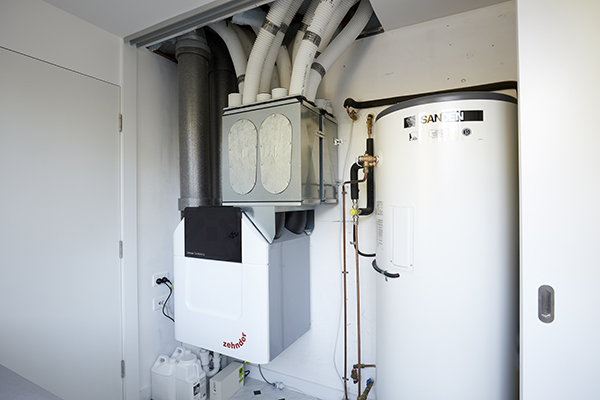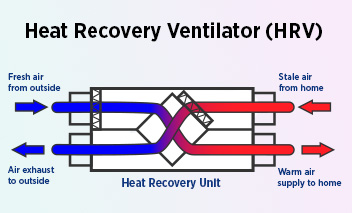Checking out the Perks of Heat Recovery Ventilation for Power Efficiency in Houses
Heat Recovery Ventilation (HRV) systems supply home owners a sensible approach to enhancing energy performance. By reclaiming warmth from outward bound air, these systems can significantly lower cooling and heating expenses. Additionally, they offer a steady supply of fresh air, boosting indoor air high quality and convenience degrees. As homeowners think about lasting choices, comprehending the subtleties of HRV systems comes to be increasingly crucial. What variables should one review before making such an investment?
Understanding Heat Recovery Ventilation Solutions

Exactly How HRV Improves Indoor Air Quality

Energy Cost Savings: The Financial Benefits of HRV
Taking full advantage of energy performance, heat recovery ventilation (HRV) systems supply substantial financial benefits for home owners. By recovering and reusing heat from exhaust air, HRVs considerably lower heating & cooling expenses. This technology can cause power cost savings of as much as 30%, relying on environment and usage patterns. Homeowners commonly see reduced energy costs soon after installment, making HRVs a webpage financially sensible investment with time. Additionally, many regions provide rewards or refunds for energy-efficient upgrades, better enhancing the economic appeal. As power costs proceed to increase, the cost-effectiveness of HRVs becomes increasingly clear. Generally, the incorporation of HRV systems not only advertises power effectiveness yet also contributes to lasting economic cost savings for homes.
The Environmental Impact of Heat Recovery Ventilation
A substantial environmental advantage of heat recovery ventilation (HRV) systems hinges on their ability to decrease total energy usage. By reclaiming warm from exhaust air and transferring it to inbound fresh air, HRV systems lessen the demand for energy-intensive home heating and cooling techniques. This reduction in energy need contributes to lower greenhouse gas emissions, as less nonrenewable fuel source is required to preserve comfy interior temperatures. Additionally, HRV systems improve indoor air top quality by efficiently exchanging stale air with fresh outdoor air, reducing reliance on mechanical cooling systems that can harm the setting. Overall, the execution of HRV systems supports sustainable living methods and lines up with global efforts to combat environment modification by advertising energy performance in property settings.
Choosing the Right HRV System for Your Home
How can home owners assure they select the right heat recovery ventilation (HRV) system for their demands? They ought to examine their home's size and layout, as these elements affect airflow demands. Next off, see it here reviewing the system's performance check out this site ratings is important, as greater ratings indicate better efficiency and energy financial savings. Property owners should likewise consider setup and maintenance costs, contrasting different brands and versions for worth. Additionally, it is very important to assess noise levels, as some systems operate even more silently than others. Consulting with heating and cooling professionals can offer tailored referrals based on details home conditions. Finally, checking out individual reviews and warranties can assist in making an informed choice, guaranteeing that the selected HRV system effectively boosts interior air high quality and energy efficiency.
Often Asked Concerns

Just how Often Should I Clean or Keep My HRV System?
The regularity of cleaning or maintaining a warmth recovery ventilation (HRV) system generally depends on usage and ecological factors. Typically, it is suggested to perform upkeep every 6 months to guarantee peak performance and air high quality.

Can HRV Equipments Help In Reducing Moisture Levels Inside?
HRV systems can properly minimize indoor humidity levels by exchanging stale, humid air with fresh, drier air from outdoors. HRV Heat Recovery Ventilation. This process assists maintain a balanced indoor setting, improving comfort and avoiding moisture-related issues
What Is the Lifespan of a Common HRV System?
The life expectancy of a regular heat recovery ventilation (HRV) system varies, generally lasting in between 10 to 15 years. Routine maintenance can expand its effectiveness and operational life, ensuring peak performance throughout its use duration.
Are There Any Type Of Sound Issues With HRV Equipments?
Sound worry about HRV systems can develop, specifically from follower operation. However, several modern-day units are designed to minimize sound degrees, ensuring they operate silently while maintaining effectiveness, which addresses prospective disturbances in living settings.
Can I Set Up an HRV System Myself, or Do I Required an Expert?
The specific contemplated whether to mount the heat recovery ventilation (HRV) system directly or hire a specialist. Usually, while DIY installment is possible, proficiency warranties appropriate functionality and conformity with neighborhood building codes, improving system effectiveness.